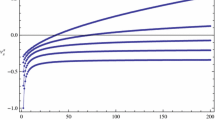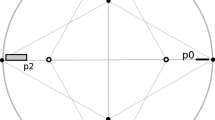Abstract
The search for optimal configurations of pointsets, the most notable examples being the problems of Kepler and Thompson, have an extremely rich history with diverse applications in physics, chemistry, communication theory, and scientific computing. In this paper, we introduce and study a new optimality criteria for pointset configurations. Namely, we consider a certain weighted graph associated with a pointset configuration and seek configurations that minimize certain spectral properties of the adjacency matrix or graph Laplacian defined on this graph, subject to geometric constraints on the pointset configuration. This problem can be motivated by solar cell design and swarming models, and we consider several spectral functions with interesting interpretations such as spectral radius, algebraic connectivity, effective resistance, and condition number. We prove that the regular simplex extremizes several spectral invariants on the sphere. We also consider pointset configurations on flat tori via (i) the analogous problem on lattices and (ii) through a variety of computational experiments. For many of the objectives considered (but not all), the triangular lattice is extremal.







Similar content being viewed by others
Notes
In some contexts, \(L^{{\mathbf {x}}}\) is referred to as the weighted unnormalized graph Laplacian [37], but we do not consider any of the other graph Laplacians here.
The Voronoi cell is also sometimes referred to as the Dirichlet cell or Wigner–Seitz cell.
A matrix \(A\in {\mathbb {Z}}^{n\times n}\) is unimodular if \(\mathrm {det} A =\pm 1\).
References
Arenas, A., Díaz-Guilera, A., Kurths, J., Moreno, Y., Zhou, C.: Synchronization in complex networks. Phys. Rep. 469(3), 93–153 (2008). doi:10.1016/j.physrep.2008.09.002
Baernstein II, A.: A minimum problem for heat kernels of flat tori. Contemp. Math. 201, 227–243 (1997). doi:10.1090/conm/201/02604
Ballinger, B., Blekherman, G., Cohn, H., Giansiracusa, N., Kelly, E., Schürmann, A.: Experimental study of energy-minimizing point configurations on spheres. Exp. Math. 18(3), 257–283 (2009). doi:10.1080/10586458.2009.10129052
Belkin, M., Niyogi, P.: Laplacian eigenmaps for dimensionality reduction and data representation. Neural Comput. 15(6), 1373–1396 (2003). doi:10.1162/089976603321780317
Belkin, M., Niyogi, P., Sindhwani, V.: Manifold regularization: a geometric framework for learning from labeled and unlabeled examples. J. Mach. Learn. Res. 7, 2399–2434 (2006)
Berger, M.: Sur les premiéres valeurs propres des variétés Riemanniennes. Compos. Math. 26(2), 129–149 (1973)
Bétermin, L.: 2d theta functions and crystallization among Bravais lattices (2015). ArXiv: 1502.03839
Bétermin, L., Zhang, P.: Minimization of energy per particle among Bravais lattices in \({R}^2\): Lennard–Jones and thomas-fermi cases. Commun. Contemp. Math. 17(6), 1450,049 (2015). doi:10.1142/S0219199714500497
Biyikoglu, T., Leydold, J., Stadler, P.F.: Laplacian Eigenvectors of Graphs. Springer, Berlin (2007). doi:10.1007/978-3-540-73510-6
Björner, A., Lovász, L., Shor, P.W.: Chip-firing games on graphs. Eur. J. Comb. 12(4), 283–291 (1991). doi:10.1016/s0195-6698(13)80111-4
Borodachov, S.V., Hardin, D.P., Saff, E.B.: Low complexity methods for discretizing manifolds via Riesz energy minimization. Found. Comput. Math. 14(6), 1173–1208 (2014). doi:10.1007/s10208-014-9202-3
Borwein, J.M., Lewis, A.S.: Convex Analysis and Nonlinear Optimization. Springer, Berlin (2006). doi:10.1007/978-0-387-31256-9
Boumal, N., Singer, A., Absil, P.A., Blondel, V.D.: Cramér–Rao bounds for synchronization of rotations. Inf. Inference 3(1), 1–39 (2013). doi:10.1093/imaiai/iat006
Boyd, S., Diaconis, P., Xiao, L.: Fastest mixing Markov chain on a graph. SIAM Rev. 46(4), 667–689 (2004). doi:10.1137/s0036144503423264
Cassels, J.W.S.: On a problem of Rankin about the Epstein zeta function. Proc. Glasg. Math. Assoc. 4, 73–80 (1959). doi:10.1017/s2040618500033906
Chung, F.R.K.: Spectral Graph Theory. AMS, Providence (1997). doi:10.1090/cbms/092
Cohen-Tannoudji, C., Dupont-Roc, J., Grynberg, G.: Atom–Photon Interactions. Wiley-Interscience, New York (1992). doi:10.1002/9783527617197
Cohn, H.: Order and disorder in energy minimization. In: Proceedings of the International Congress of Mathematicians, Hyderabad, India (2010). doi:10.1142/9789814324359_0152
Cohn, H., Kumar, A.: Universally optimal distribution of points on spheres. J. Am. Math. Soc. 20(1), 99–148 (2007). doi:10.1090/S0894-0347-06-00546-7
Conway, J., Sloane, N.J.A.: Sphere Packings, Lattices and Groups, 3rd edn. Springer, Berlin (1999). doi:10.1007/978-1-4757-6568-7
Cucker, F., Smale, S.: Emergent behavior in flocks. IEEE Trans. Autom. Control 52(5), 852–862 (2007). doi:10.1109/tac.2007.895842
Cucker, F., Smale, S.: On the mathematics of emergence. Jpn. J. Math. 2(1), 197–227 (2007). doi:10.1007/s11537-007-0647-x
Damelin, S.B., Grabner, P.J.: Energy functionals, numerical integration and asymptotic equidistribution on the sphere. J. Complex. 19(3), 231–246 (2003). doi:10.1016/s0885-064x(02)00006-7
Diananda, P.H.: Notes on two lemmas concerning the Epstein zeta function. Proc. Glasg. Math. Assoc. 6, 202–204 (1964). doi:10.1017/s2040618500035036
Economou, E.N.: Green’s Functions in Quantum Physics, vol. 7. Springer, Berlin (1983). doi:10.1007/978-3-662-02369-3
Ennola, V.: A lemma about the Epstein zeta function. Proc. Glasg. Math. Assoc. 6, 198–201 (1964). doi:10.1017/s2040618500035024
Fiedler, M.: Algebraic connectivity of graphs. Czech. Math. J. 23, 298–305 (1973)
Ganapati, V., Miller, O.D., Yablonovitch, E.: Light trapping textures designed by electromagnetic optimization for subwavelength thick solar cells. IEEE J. Photovol. 4(1), 175–182 (2014). doi:10.1109/jphotov.2013.2280340
Ghosh, A., Boyd, S.: Growing well-connected graphs. In: Proceedings of the IEEE Conference Decision and Control, pp. 6605–6611 (2006). doi:10.1109/cdc.2006.377282
Ghosh, A., Boyd, S.: Upper bounds on algebraic connectivity via convex optimization. Linear Algebra Appl. 418, 693–707 (2006). doi:10.1016/j.laa.2006.03.006
Ghosh, A., Boyd, S., Saberi, A.: Minimizing effective resistance of a graph. SIAM Rev. 50(1), 37–66 (2008). doi:10.1137/050645452
Godsil, C.D., Mohar, B.: Walk generating functions and spectral measures of infinite graphs. Linear Algebra Appl. 107, 191–206 (1988). doi:10.1016/0024-3795(88)90245-5
Kao, C.Y., Lai, R., Osting, B.: Maximization of Laplace–Beltrami eigenvalues on closed Riemannian surfaces. ESAIM Control Optim. Calc. Var. (2016). doi:10.1051/cocv/2016008
Kirr, E., Weinstein, M.I.: Parametrically excited Hamiltonian partial differential equations. SIAM J. Appl. Math. 33(1), 16–52 (2001). doi:10.1137/s0036141099363456
Kirr, E., Weinstein, M.I.: Metastable states in parametrically excited multimode Hamiltonian systems. Commun. Math. Phys. 236(2), 335–372 (2003). doi:10.1007/s00220-003-0820-x
Lin, L., Saad, Y., Yang, C.: Approximating spectral densities of large matrices. SIAM Rev. 58(1), 34–65 (2016). doi:10.1137/130934283
Luxburg, U.V.: A tutorial on spectral clustering. Stat. Comput. 17(4), 395–416 (2007). doi:10.1007/s11222-007-9033-z
Marcotte, E., Stillinger, F.H., Torquato, S.: Unusual ground states via monotonic convex pair potentials. J. Chem. Phys. 134(16), 164,105 (2011). doi:10.1063/1.3576141
Matoušek, J.: Geometric Discrepancy: An Illustrated Guide. Springer, Berlin (1999). doi:10.1007/978-3-642-03942-3
Miller, O.D.: Photonic design: from fundamental solar cell physics to computational inverse design. arXiv: 1308.0212 (2013)
Miller, O.D., Yablonovitch, E.: Photon extraction: the key physics for approaching solar cell efficiency limits. In: Proceedings of the SPIE 8808, Active Photonic Materials, p. 880807 (2013). doi:10.1117/12.2024592
Mohar, B.: The Laplacian spectrum of graphs. In: Alavi, Y., Chartrand, G., Oellermann, O.R., Schwenk, A.J. (eds.) Graph Theory, Combinatorics, and Applications, vol. 2, pp. 871–898. Wiley (1991)
Mohar, B., Woess, W.: A survey on spectra of infinite graphs. Bull. Lond. Math. Soc. 21(3), 209–234 (1989). doi:10.1112/blms/21.3.209
Montgomery, H.L.: Minimal theta functions. Glasg. Math. J. 30(1), 75–85 (1988). doi:10.1017/s0017089500007047
Motsch, S., Tadmor, E.: A new model for self-organized dynamics and its flocking behavior. J. Stat. Phys. 144(5), 923–947 (2011). doi:10.1007/s10955-011-0285-9
Olfati-Saber, R., Fax, A., Murray, R.M.: Consensus and cooperation in networked multi-agent systems. Proc. IEEE 95(1), 215–233 (2007). doi:10.1109/jproc.2006.887293
Osting, B., Brune, C., Osher, S.: Enhanced statistical rankings via targeted data collection. JMLR W&CP 28(1), 489–497 (2013)
Osting, B., Brune, C., Osher, S.: Optimal data collection for informative rankings expose well-connected graphs. J. Mach. Learn. Res. 15, 2981–3012 (2014)
Osting, B., Marzuola, J.L., Cherkaev, E.: An isoperimetric inequality for integral operators on flat tori. Ill. J. Math. 59(3), 773–793 (2015). http://projecteuclid.org/euclid.ijm/1475266407
Osting, B., Weinstein, M.I.: Emergence of periodic structure from maximizing the lifetime of a bound state coupled to radiation. SIAM J. Multiscale Model. Simul. 9(2), 654–685 (2011). doi:10.1137/100813221
Purcell, E.M.: Spontaneous emission probabilities at radio frequencies. Phys. Rev. 69, 681 (1946)
Purcell, E.M.: Research in nuclear magnetism. Science 118(3068), 431–436 (1953)
Rankin, R.A.: A minimum problem for the Epstein zeta-function. In: Proceedings of the Glasgow Mathematical Association, vol. 1, pp. 149–158 (1953). doi:10.1017/s2040618500035668
Saff, E.B., Kuijlaars, A.B.J.: Distributing many points on a sphere. Math. Intell. 19(1), 5–11 (1997). doi:10.1007/bf03024331
Shannon, C.E.: A mathematical theory of communication. ACM SIGMOBILE Mob. Comput. Commun. Rev. 5(1), 3–55 (2001)
Shi, J., Malik, J.: Normalized cuts and image segmentation. IEEE Trans. Pattern Anal. Mach. Intell. 22(8), 888–905 (2000). doi:10.1109/34.868688
Singer, A.: From graph to manifold Laplacian: the convergence rate. Appl. Comput. Harmonic Anal. 21(1), 128–134 (2006). doi:10.1016/j.acha.2006.03.004
Smale, S.: Mathematical problems for the next century. Math. Intell. 20(2), 7–15 (1998). doi:10.1007/bf03025291
Sun, J., Boyd, S., Xiao, L., Diaconis, P.: The fastest mixing Markov process on a graph and a connection to a maximum variance unfolding problem. SIAM Rev. 48(4), 681–699 (2006). doi:10.1137/s0036144504443821
Thomson, J.J.: On the structure of the atom: an investigation of the stability and periods of oscillation of a number of corpuscles arranged at equal intervals around the circumference of a circle; with application of the results to the theory of atomic structure. Philos. Mag. Ser. 6 7(39), 237–265 (1904). doi:10.1080/14786440409463107
Torquato, S., Stillinger, F.H.: Jammed hard-particle packings: from Kepler to Bernal and beyond. Rev. Mod. Phys. 82(3), 2633–2672 (2010). doi:10.1103/revmodphys.82.2633
Tóth, L.F.: Regular Figures. Pergamon Press, Oxford (1964)
Van Hove, L.: The occurrence of singularities in the elastic frequency distribution of a crystal. Phys. Rev. 89(6), 1189–1193 (1953). doi:10.1103/physrev.89.1189
Wendland, H.: Scattered Data Approximation. Cambridge University Press, Cambridge (2004). doi:10.1017/cbo9780511617539
Whyte, L.L.: Unique arrangements of points on a sphere. Am. Math. Mon. 59(9), 606–611 (1952). doi:10.2307/2306764
Yablonovitch, E.: Inhibited spontaneous emission in solid-state physics and electronics. Phys. Rev. Lett. 58(20), 2059–2062 (1987). doi:10.1103/physrevlett.58.2059
Yu, Z., Raman, A., Fan, S.: Fundamental limit of nanophotonic light trapping in solar cells. Proc. Natl. Acad. Sci. 107(41), 17491–17496 (2010). doi:10.1073/pnas.1008296107
Acknowledgements
The authors would like to thank Mikael Rechtsman for starting them down the path of this work, as well as Laurent Betermin, Elena Cherkaev, Owen Miller, and Peter Mucha for valuable discussions along the way to completing it.
Author information
Authors and Affiliations
Corresponding author
Additional information
Communicated by Edward B. Saff.
BO gratefully acknowledges support from NSF DMS-1461138 and NSF DMS-1619755. JLM is supported by NSF Applied Math Grant DMS-1312874 and NSF CAREER Grant DMS-1352353.
Appendices
Appendix A: Sensitivity Analysis of Spectral Quantities
In Sects. 2.1 and 2.2, we introduced the weighted adjacency matrix and graph Laplacian associated to a pointset configuration, discussed some spectral properties of the matrices, and recalled a variety of spectral quantities that are of interest in various applications. In this appendix, we discuss the sensitivity of these spectral quantities with respect to changes in the pointset configuration.
We say that a function \(J :{\mathbb {R}}^n \rightarrow {\mathbb {R}}\) is a symmetric if \(J(x) = J([x])\), where \([\cdot ]:{\mathbb {R}}^n \rightarrow {\mathbb {R}}^n\) rearranges the components of a vector in nondecreasing order. In other words, the value of J is invariant to permuting the components of the argument. Recall that we have defined \(\mathbf{S}^n\) to be the set of real symmetric \(n \times n\) matrices, and let \(\lambda :\mathbf{S}^n \rightarrow {\mathbb {R}}^n\) be the vector containing the ordered eigenvalues of a symmetric matrix. We say that the composition \(J\circ \lambda \) is a spectral function if J is a symmetric function. Roughly speaking, \(J\circ \lambda \) is convex and differentiable when J is convex and differentiable [12].
Recall that the weighted adjacency matrix associated with a Euclidean pointset \(\{{{\mathbf {x}}}_i \}_{i\in [n]}\) is defined as in (2). For the spectral function \(J\circ \lambda \), we consider the composition
The following proposition shows how the composite function, \( J \circ \lambda \circ W^{{\mathbf {x}}}\), changes as we move a single point in the configuration, say \({{\mathbf {x}}}_i \in {\mathbb {R}}^d\).
Proposition A.1
Let J be differentiable at \(\lambda (W^{{\mathbf {x}}})\). The gradient of the objective function, \( J \circ \lambda \circ W^{{\mathbf {x}}}:{\mathbb {R}}^{N\times 2} \rightarrow {\mathbb {R}}\), with respect to \({{\mathbf {x}}}_i\) is given by
for any diagonalizing matrix \(U\in O^n\) satisfying \(W^{{\mathbf {x}}}= U \ \mathrm {diag}\ \lambda (W^{{\mathbf {x}}}) \ U^t\).
Proof
The proof is an exercise in the chain rule. When J is differentiable at \(\lambda (A)\), the composition \(J\circ \lambda :\mathbf{S}^N \rightarrow {\mathbb {R}}\) is Fréchet differentiable with derivative
for any diagonalizing matrix \(U\in O^n\) satisfying \(A = U \ \mathrm {diag}\ \lambda (A) \ U^t\). See, for example, [12, Corollary 5.2.5]. For simplicity, we write \(V = U \ \mathrm {diag} \nabla J (\lambda ) \ U^t\). Thus, we compute
In (30a), \(\langle \cdot , \cdot \rangle _F \) denotes the Frobenius inner product. In (30c), \(\delta _{ij}\) denotes the Kronecker delta function. In (30e), we used the symmetry of V and W. We compute
from which the result follows. \(\square \)
Example
Consider the spectral function \(J(\lambda ) = \sum _i \lambda _i^2\). In this case, \(U \ \mathrm {diag} \nabla J (\lambda ) \ U^t = 2 W^{{\mathbf {x}}}\). Thus from Proposition A.1 we can check that
This is a trivial identity since \( \Vert W^{{\mathbf {x}}}\Vert _F^2 = \mathrm {tr} [ (W^{{\mathbf {x}}})^2 ] = \sum _i \lambda _i(W^{{\mathbf {x}}})^2\).
As in (3), the graph Laplacian associated with a pointset \(\{{{\mathbf {x}}}_i \}_{i\in [n]}\) is given by \(L^{{\mathbf {x}}}= D^{{\mathbf {x}}}- W^{{\mathbf {x}}}\). For the spectral function \(J\circ \lambda \), we consider the composition
The following proposition shows how this composite function, \( J \circ \lambda \circ L^{{\mathbf {x}}}\), changes as we move a single point in the configuration, say \({{\mathbf {x}}}_i \in {\mathbb {R}}^n\).
Proposition A.2
Let J be differentiable at \(\lambda (L^{{\mathbf {x}}})\). The gradient of the objective function, \( J \circ \lambda \circ L^{{\mathbf {x}}}:{\mathbb {R}}^{N\times 2} \rightarrow {\mathbb {R}}\), with respect to \({{\mathbf {x}}}_i\) is given by
where \(V = \left( U \ \mathrm {diag} \nabla J (\lambda ) \ U^t \right) _{ik}\) for any diagonalizing matrix \(U\in O^n\) satisfying \(L^{{\mathbf {x}}}= U \ \mathrm {diag}\ \lambda (L^{{\mathbf {x}}}) \ U^t\). The gradient can alternatively be expressed using the arc-vertex incidence matrix decomposition (7),
where \(g = \sum _{j=1}^n (Bu_j)^2 \big ( \nabla J(\lambda ) \big )_j\).
Proof
As in the proof of Proposition A.1, when J be differentiable at \(\lambda (L^{{\mathbf {x}}})\), the composition \(J\circ \lambda :\mathbf{S}^n \rightarrow {\mathbb {R}}\) is Fréchet differentiable with derivative
for any diagonalizing matrix \(U\in O^n\) satisfying \(L^{{\mathbf {x}}}= U \ \mathrm {diag} \lambda (L^{{\mathbf {x}}}) \ U^t\). Writing \(V = U \ \mathrm {diag} \nabla J (\lambda ) \ U^t\), it follows that
where we used (30e). From
we then have that
Equation (32) now follows from (31).
From (34), we could also write
where
Thus, \(g\in {\mathbb {R}}^{\left( {\begin{array}{c}n\\ 2\end{array}}\right) }\) has entries given by
Finally, we compute
which gives (33). \(\square \)
Example
Consider the spectral function \(J(\lambda ) = \sum _i \lambda _i\) so that the objective function is simply \(\text {tr} L^{{\mathbf {x}}}\). In this case, \(V= \text {Id}\), and
Remark A.3
Equation (35) in the proof of Proposition A.2 implies that the variation of a spectral function of the graph Laplacian with respect to the edge weights is generally given by
For example, the gradient of the trace, \( \text {tr} L(w)\), is given by
The factor of two simply indicates that each edge weight effects the degree of two vertices. When \(\lambda _2 \big ( L(w)\big )\) is a simple eigenvalue, the gradient is given by
which agrees with the formulas in [29, 30]. Finally, the gradient of the total effective resistance, \(R_{tot} = \sum _j \lambda _j^{-1}\), is computed
which can also be found in [31].
For a general spectral function J, the gradients computed in Propositions A.1 and A.2 can be used together with a quasi-Newton optimization method to efficiently search for a locally optimal pointset configuration; see Sect. 5.
Appendix B: Parameterization of Lattices
Let \(B = [b_1,\ldots ,b_n]\in {\mathbb {R}}^{n\times n}\) have linearly independent columns. The lattice generated by the basis B is the set of integer linear combinations of the columns of B,
Let B and C be two lattice bases. We recall that \({\mathcal {L}}(B)={\mathcal {L}}(C)\) if and only if there is a unimodularFootnote 3 matrix U such that \(B = CU\). Thus, there is a one-to-one correspondence between the unimodular \(2\times 2\) matrices and the bases of a two-dimensional lattice.
We say that two lattices are isometric if there is a rigid transformation that maps one to the other. The following proposition parameterizes the space of two-dimensional, unit-volume lattices modulo isometry.
Proposition B.1
Every two-dimensional lattice with volume one is isometric to a lattice parameterized by the basis
where the parameters a and b are constrained to the set
The set U defined in Proposition B.1 is illustrated in Fig. 8.
The set U in Proposition B.1. Parameters (a, b) corresponding to square, triangular, rectangular, rhombic, and oblique lattices are also indicated
Proof
Consider an arbitrary lattice with unit volume. We first choose the basis vectors so that the angle between them is acute. After a suitable rotation and reflection, we can let the shorter basis vector (with length \(\frac{1}{\sqrt{b}}\)) be parallel to the x axis and the longer basis vector (with length \( \sqrt{ \frac{a^2}{b} + b} = \sqrt{\frac{1}{b} \left( a^2 + b^2 \right) } \ge \sqrt{ \frac{1}{b}}\)) lie in the first quadrant. Multiplying on the right by a unimodular matrix, \( \begin{pmatrix} 1 &{} 1 \\ 0 &{} 1 \end{pmatrix}\), we compute
Since this is equivalent to taking \(a\mapsto a+1\), it follows that we can identify the lattices associated with the points (a, b) and \((a+1,b)\). Thus, we can restrict the parameter a to the interval \(\left[ 0, 1/2 \right] \) by symmetry. For a complete picture of this restriction and how the symmetry naturally arises, see [33, Proposition 3.2 Figure 3]. \(\square \)
Rights and permissions
About this article
Cite this article
Osting, B., Marzuola, J. Spectrally Optimized Pointset Configurations. Constr Approx 46, 1–35 (2017). https://doi.org/10.1007/s00365-017-9365-7
Received:
Revised:
Accepted:
Published:
Issue Date:
DOI: https://doi.org/10.1007/s00365-017-9365-7
Keywords
- Eigenvalue optimization
- Density of states
- Potential energy minimization
- Universal optimality
- Regular polytopes
- Triangular lattice





